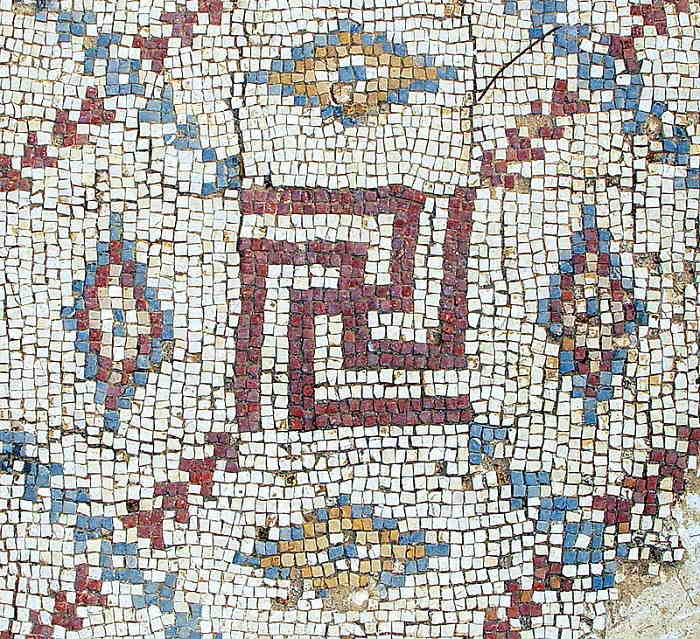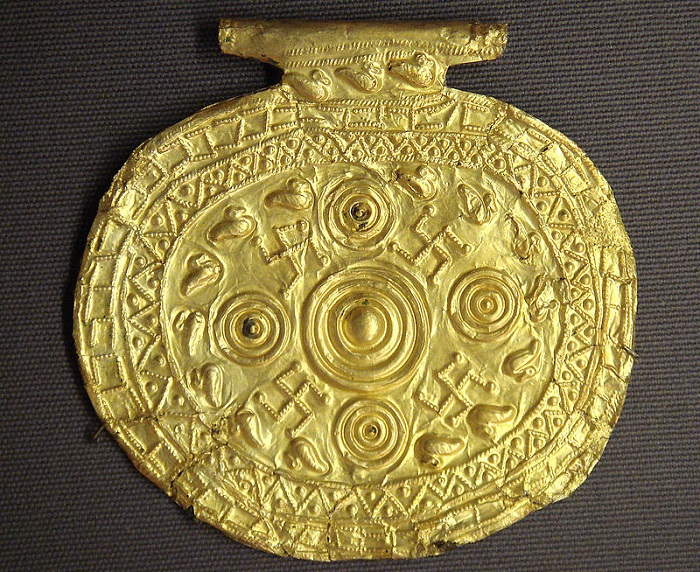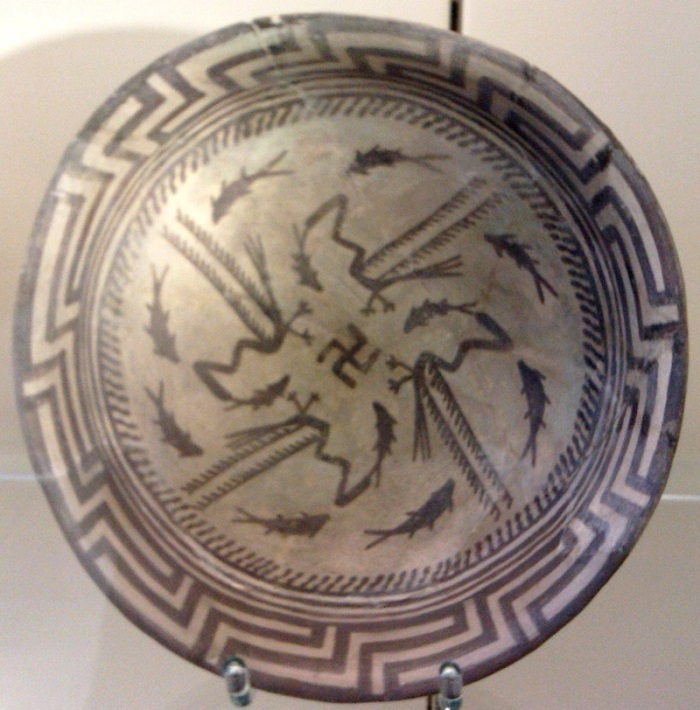The swastika (卐 or卍) is an age-old symbol in religions across Asia, Europe and Africa, having positive connotations like good luck, life or prosperity. It is also infamous for being the symbol of Nazism, Aryan supremacy and anti-Semitism during World War II. Found in ancient Indian religious texts millennia ago, archaeological artefacts found across the world corroborate the swastika’s existence. Due to its corrupted and controversial meaning, many countries across the world have now banned the use of swastika. But the symbol is still used by people and religions across the world, mostly in a positive sense.
The Origins of the Swastika
The actual swastika symbol (as a hooked cross) was first used about 15,000 years ago on a bird figurine found in Ukraine. Thereafter, it has been one of the most widely used icons in human history. Archaeologists and historians have found the swastika on several artefacts like pottery, jewellery, weaponry, artwork as well as in archaeological ruins, historical buildings, temples, churches, etc. around the world. The swastika symbol, called by different names, was used throughout the Neolithic period, Indus Valley Civilization in the Indian sub-continent, Bronze Age in China, ancient Greek civilization, Byzantine era, early Christianity period of Ethiopia, Iron Age in Eurasia, and the Migration Period, Viking and Gothic ages in Europe. It has also held different meanings in different cultures, sometimes as the sun, the North Pole, or even a comet. Making its foremost appearance in the written form in the ancient Indian religious text, the Vedas, the swastika symbol also entered several East-Asian languages like that of China and Japan by means of script and characters in their writing systems.
 Image Source: https://en.wikipedia.org/wiki/Swastika
Image Source: https://en.wikipedia.org/wiki/Swastika
Meaning of Swastika
Swastika is derived from the Sanskrit word ‘swastik’, which is composed of ‘su’ which means ‘good, well’, ‘asti’ meaning ‘to be’, and ‘ka’ as a suffix – all of which combined ultimately mean ‘well-being’. Swastika is mentioned quite often in the ancient Indian religious texts, Vedas, to signify prosperity, success and good luck.
Religions such as Hinduism, Buddhism, Jainism, Christianity, and Greek and Roman mythology, etc. have attributed varied meanings to the swastika. In Hinduism, the clockwise swastika (a swastika that has its arms pointing outward, clockwise) is called ‘swastika’ and represents the sun god ‘Surya’; it depicts the sun’s movement across the sky – from east to west. Its counter-clockwise symbol, the ‘sauvastika’ depicts the opposite notion; that of the night and Tantric rituals associated with the terrifying goddess ‘Kali’.
In Buddhism, the swastika stands for prosperity, spirituality and good fortune. In Jainism, it is a symbol for one their spiritual teachers – the ‘Suparshvanatha’. In Christianity, as a hooked version of the Cross, it represents the victory of Christ over death.
The Phoenicians referred to the swastika as a sacred symbol of the sun. The ancient religions of Europe have used the swastika as a symbol of the lightning bolt, which depicts the Norse god ‘Thor’, Roman god ‘Jupiter’, and Greek god ‘Zeus’. Some Native American tribes also used the swastika symbol to denote ‘good luck’.
The growing interest of Europeans in Eastern religions and philosophies led to a renewed popularity of the swastika. The discovery of archaeological artefacts in Troy that had swastika motifs on them further fuelled the fascination of certain racist groups in Germany. A modified version of the swastika was ultimately adopted as the symbol of the Nazi Party in 1920. This unfortunately changed the meaning of the swastika forever as it represented the oppression and genocide of millions of Jews during World War II; it soon became a symbol of hatred the world over. However, the Nazi party was not the first one to use the swastika as a party logo in Germany. Since it was linked to the idea of a ‘pure race’, many nationalist groups in Germany had begun using it after World War I.
 Image Source: https://en.wikipedia.org/wiki/Swastika
Image Source: https://en.wikipedia.org/wiki/Swastika
Significance of Swastika During Nazi Rule
The unearthing of swastika-emblazoned artefacts in Troy by German archaeologist, Heinrich Schliemann, coupled with the discovery of similarities between Indian-Sanskrit and German languages, led many German nationalists to believe in a link between the two cultures, probably an ancient dominant race called the ‘Aryans’. Very soon, the swastika became an icon of German nationalist pride, and in 1920, the Nazi party adopted an angled version of the swastika (called the ‘Hakenkreuz’ or a ‘hooked cross’) as its official logo.
Designed by Adolf Hitler himself, the Nazi party logo was created using the swastika and beloved German colours (red, black and white) symbolic of the country’s superior history. Rotated at a clockwise angle of 45 degrees, with the hooks pointing outward, and placed on a while circle against a red background, the modified swastika became the Nazi party’s emblem; it was seen on all party paraphernalia like armbands, uniforms, election posters, flags and badges. It was also widely used across all military and government organizations under the Nazi rule in Germany. Hitler even had a personalized version of the swastika made for him.
Out of fear or respect, by 1933, most products in Germany carried the Nazi party’s swastika symbol – from cigarettes to coffee to cake pans! Soon, a law was passed to prohibit the commercial use of the swastika in Germany. Adding a racist twist to it, the law stipulated that Jews could not use the swastika symbol, display the national colours or raise the new German flag.
The swastika findings at the archaeological site in Troy led the Nazis to believe in the superiority of the Aryans over other races, especially the Jews. This subsequently gave way to the passage of racially abusive Nuremberg Race Laws of 1935.
During the course of the war, as a slap in the face of the Nazi party, pilots of the Allied forces often marked their victories over Germany with a swastika on the fuselage of their planes.
 Image source: https://en.wikipedia.org/wiki/Swastika
Image source: https://en.wikipedia.org/wiki/Swastika
Ban on the Use of the Swastika After World War II
Where the swastika had been used to signify a positive meaning since ages immemorial, its misinterpreted and corrupted usage by the Nazi party led to its shameful decline as a symbol of racism, White supremacy and Holocaust, after World War II. After Germany’s defeat at the hands of the Allied forces in 1945, the swastika became one of the most hated symbols of all time; its use was outlawed in post-war Germany and all propaganda containing the swastika was destroyed. Most European states, including Germany and Austria, passed laws prohibiting the use of swastika in any form, on any medium.
Other Western countries, like the United States, were able to pass slightly less stringent laws regarding the use swastika and other neo-Nazi symbols, on account of their free speech laws.
Subsequently, any reference to the swastika in any form by any entity, individual or corporation, was heavily investigated and penalized. The apparel corporation, Espirit Holdings, and the publication house, Reichsbahn, were two such examples in Germany.
What Does the Swastika Mean Now?
In spite of the hatred and disdain received from the Western world, the swastika continues to be a sacred symbol in many religions like Hinduism, Jainism, and Buddhism. Across India, Nepal, Sri Lanka and Indonesia, it is still widely used as a good luck symbol in homes, temples, and small establishments and on auspicious occasions like weddings and births. Various versions of the swastika have also found a place in modern-day spiritual organisations in India, China, and Eurasia.
As recently as 2013, in order to revive a positive interest in their ancient past, some Scandinavians have tried to raise awareness about the swastika as an ancient Norse mythological symbol, which has no negative meaning or any fascist connotation.
In stark contrast to Nazi imagery, these modern viewpoints cause significant confusion in contemporary society. And for those who have experienced the horrors of Holocaust, the swastika, unfortunately, continues to stand for evil.
 Image Source: https://en.wikipedia.org/wiki/Swastika
Image Source: https://en.wikipedia.org/wiki/Swastika
Does the Direction of the Swastika Matter?
What the swastika means to each individual is quite open to personal interpretation. Generally, a swastika is an upright cross with the edges of its equal-length arms bent at a right angle in the clockwise position. But as per some scholars and historians, the direction of the swastika can lend a positive or negative meaning to the symbol. A clockwise ‘swastika’, in Hinduism, stands for good luck and prosperity, whereas the counter-clockwise ‘sauvstika’ stands for night, terror and Tantric magic. Many other cultures too have attached similar meanings to the direction of the swastika. But in ancient Bon religion and Buddhism too, a left-facing swastika is considered holy.
What the swastika traditionally meant – well-being, good luck and prosperity – has been widely misunderstood, misinterpreted and used to mislead people in the last century. As recently as March 2019, an ancient Russian-Polish version of the swastika was seen on one of the dog tags of the perpetrator of the mosque shootings at Christchurch, New Zealand.
With the passage of time and a little education, the honour and reputation of the swastika can be restored to once again symbolize life, good luck and prosperity.
(Source: https://en.wikipedia.org/wiki/Swastika,
https://encyclopedia.ushmm.org/content/en/article/history-of-the-swastika,
https://www.thoughtco.com/the-history-of-the-swastika-1778288,
https://www.ancient-origins.net/myths-legends/symbol-swastika-and-its-12000-year-old-history-001312,
www.bbc.com/news/magazine-29644591, http://www.newworldencyclopedia.org/entry/Swastika#cite_note-0 )


